GENDER DIFFERENCES IN L 2 LEARNING Definitions
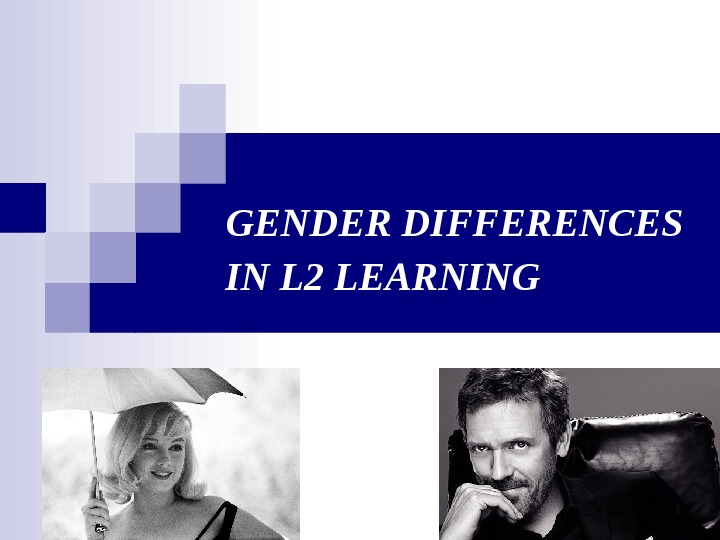
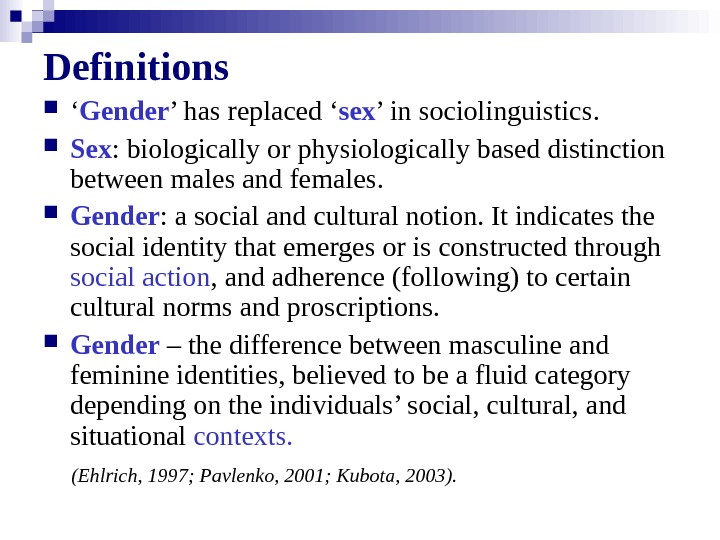

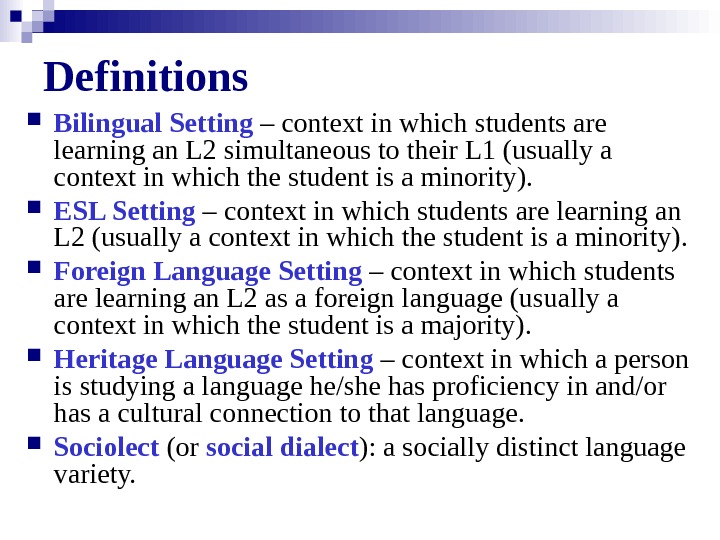
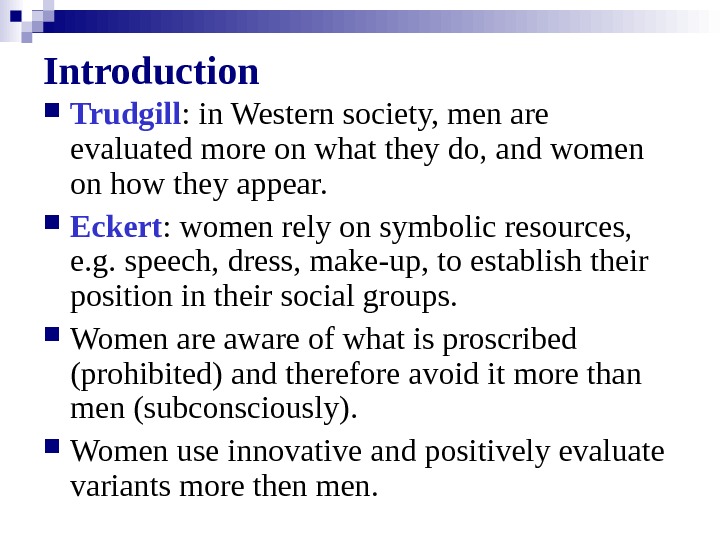
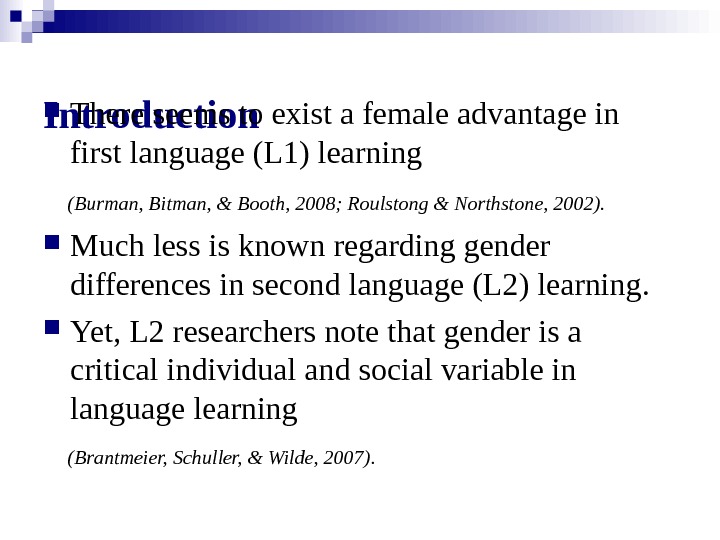
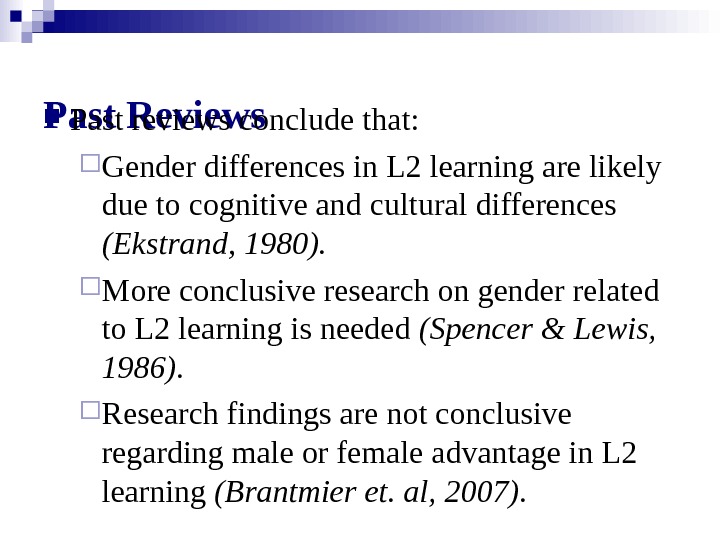
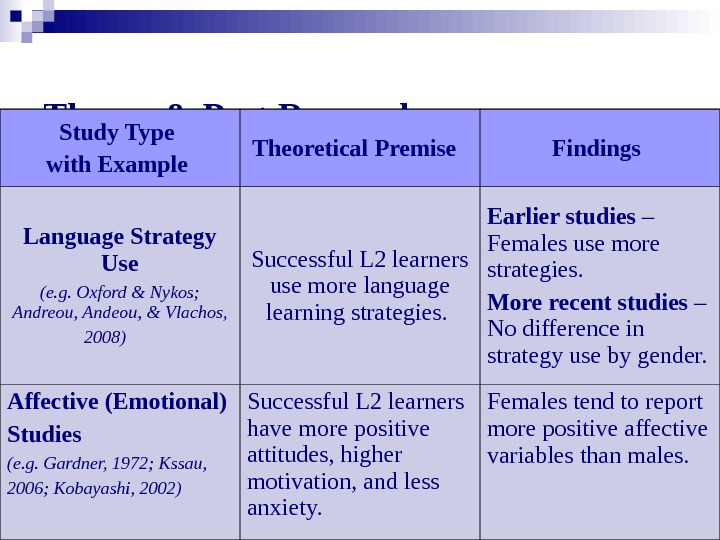
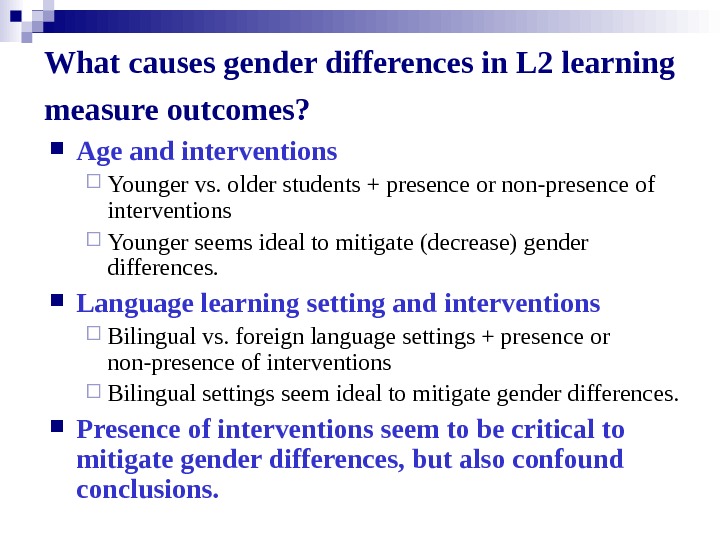
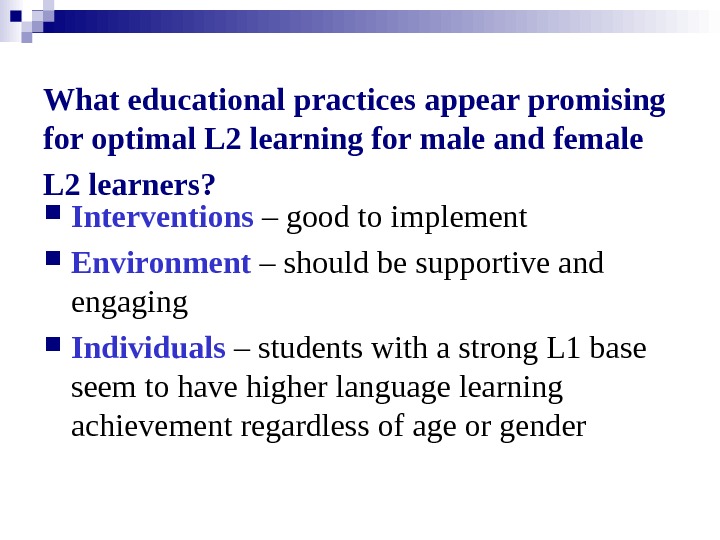
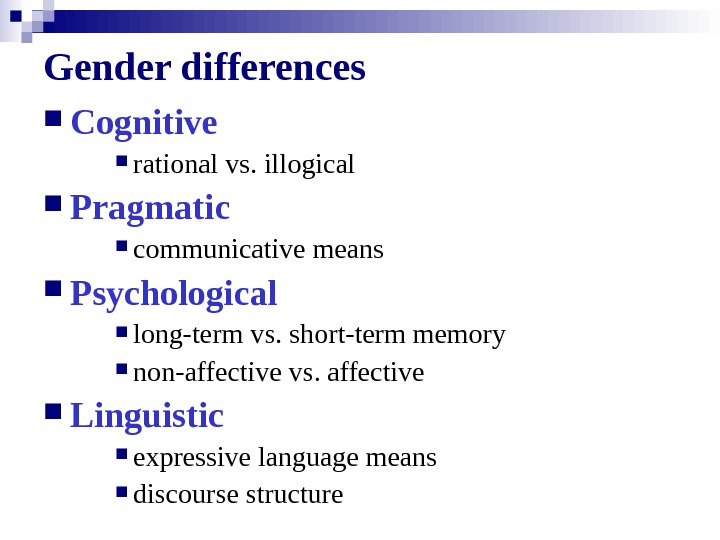

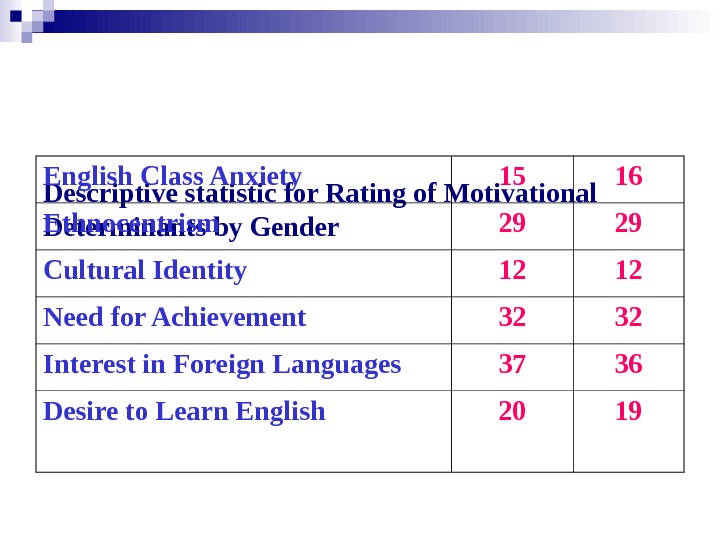

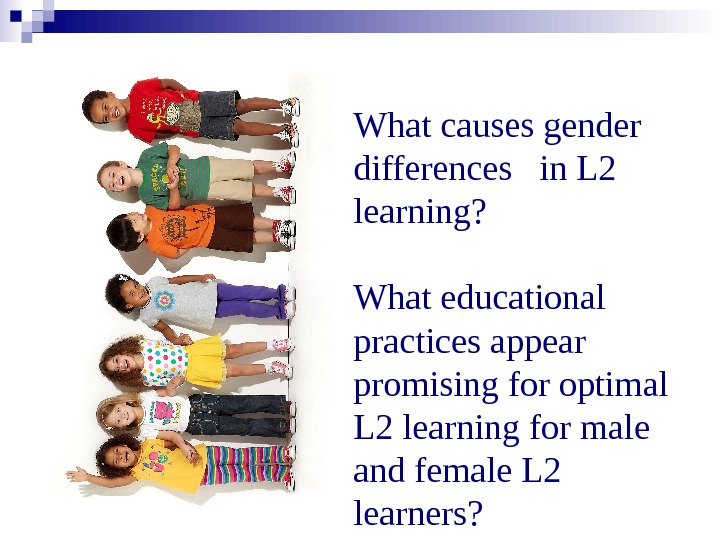


- Размер: 5.1 Mегабайта
- Количество слайдов: 17
Описание презентации GENDER DIFFERENCES IN L 2 LEARNING Definitions по слайдам
 GENDER DIFFERENCES IN L 2 LEARNING
GENDER DIFFERENCES IN L 2 LEARNING
 Definitions ‘ Gender ’ has replaced ‘ sex ’ in sociolinguistics. Sex : biologically or physiologically based distinction between males and females. Gender : a social and cultural notion. It indicates the social identity that emerges or is constructed through social action , and adherence (following) to certain cultural norms and proscriptions. Gender – the difference between masculine and feminine identities, believed to be a fluid category depending on the individuals’ social, cultural, and situational contexts. (Ehlrich, 1997; Pavlenko, 2001; Kubota, 2003).
Definitions ‘ Gender ’ has replaced ‘ sex ’ in sociolinguistics. Sex : biologically or physiologically based distinction between males and females. Gender : a social and cultural notion. It indicates the social identity that emerges or is constructed through social action , and adherence (following) to certain cultural norms and proscriptions. Gender – the difference between masculine and feminine identities, believed to be a fluid category depending on the individuals’ social, cultural, and situational contexts. (Ehlrich, 1997; Pavlenko, 2001; Kubota, 2003).
 Definitions L 1 – First language L 2 – Second language ELL – English Language Learner ESL – English as a Second Language Learning – an individual’s proficiency in language at a given time, which can be quantified as a measure from a language test. Intervention – strategies used to enhance (improve) language learning (e. g. scaffolding language; using techniques to aid comprehension; integrating listening, reading, speaking, and writing into lessons; teaching language in the content areas).
Definitions L 1 – First language L 2 – Second language ELL – English Language Learner ESL – English as a Second Language Learning – an individual’s proficiency in language at a given time, which can be quantified as a measure from a language test. Intervention – strategies used to enhance (improve) language learning (e. g. scaffolding language; using techniques to aid comprehension; integrating listening, reading, speaking, and writing into lessons; teaching language in the content areas).
 Definitions Bilingual Setting – context in which students are learning an L 2 simultaneous to their L 1 (usually a context in which the student is a minority). ESL Setting – context in which students are learning an L 2 (usually a context in which the student is a minority). Foreign Language Setting – context in which students are learning an L 2 as a foreign language (usually a context in which the student is a majority). Heritage Language Setting – context in which a person is studying a language he/she has proficiency in and/or has a cultural connection to that language. Sociolect (or social dialect ): a socially distinct language variety.
Definitions Bilingual Setting – context in which students are learning an L 2 simultaneous to their L 1 (usually a context in which the student is a minority). ESL Setting – context in which students are learning an L 2 (usually a context in which the student is a minority). Foreign Language Setting – context in which students are learning an L 2 as a foreign language (usually a context in which the student is a majority). Heritage Language Setting – context in which a person is studying a language he/she has proficiency in and/or has a cultural connection to that language. Sociolect (or social dialect ): a socially distinct language variety.
 Introduction Trudgill : in Western society, men are evaluated more on what they do, and women on how they appear. Eckert : women rely on symbolic resources, e. g. speech, dress, make-up, to establish their position in their social groups. Women are aware of what is proscribed (prohibited) and therefore avoid it more than men (subconsciously). Women use innovative and positively evaluate variants more then men.
Introduction Trudgill : in Western society, men are evaluated more on what they do, and women on how they appear. Eckert : women rely on symbolic resources, e. g. speech, dress, make-up, to establish their position in their social groups. Women are aware of what is proscribed (prohibited) and therefore avoid it more than men (subconsciously). Women use innovative and positively evaluate variants more then men.
 Introduction There seems to exist a female advantage in first language (L 1) learning (Burman, Bitman, & Booth, 2008; Roulstong & Northstone, 2002). Much less is known regarding gender differences in second language (L 2) learning. Yet, L 2 researchers note that gender is a critical individual and social variable in language learning (Brantmeier, Schuller, & Wilde, 2007).
Introduction There seems to exist a female advantage in first language (L 1) learning (Burman, Bitman, & Booth, 2008; Roulstong & Northstone, 2002). Much less is known regarding gender differences in second language (L 2) learning. Yet, L 2 researchers note that gender is a critical individual and social variable in language learning (Brantmeier, Schuller, & Wilde, 2007).
 Past Reviews Past reviews conclude that: Gender differences in L 2 learning are likely due to cognitive and cultural differences (Ekstrand, 1980). More conclusive research on gender related to L 2 learning is needed (Spencer & Lewis, 1986). Research findings are not conclusive regarding male or female advantage in L 2 learning (Brantmier et. al, 2007).
Past Reviews Past reviews conclude that: Gender differences in L 2 learning are likely due to cognitive and cultural differences (Ekstrand, 1980). More conclusive research on gender related to L 2 learning is needed (Spencer & Lewis, 1986). Research findings are not conclusive regarding male or female advantage in L 2 learning (Brantmier et. al, 2007).
 Theory & Past Research Study Type with Example Theoretical Premise Findings Language Strategy Use (e. g. Oxford & Nykos; Andreou, Andeou, & Vlachos, 2008) Successful L 2 learners use more language learning strategies. Earlier studies – Females use more strategies. More recent studies – No difference in strategy use by gender. Affective (Emotional) Studies (e. g. Gardner, 1972; Kssau, 2006; Kobayashi, 2002) Successful L 2 learners have more positive attitudes, higher motivation, and less anxiety. Females tend to report more positive affective variables than males.
Theory & Past Research Study Type with Example Theoretical Premise Findings Language Strategy Use (e. g. Oxford & Nykos; Andreou, Andeou, & Vlachos, 2008) Successful L 2 learners use more language learning strategies. Earlier studies – Females use more strategies. More recent studies – No difference in strategy use by gender. Affective (Emotional) Studies (e. g. Gardner, 1972; Kssau, 2006; Kobayashi, 2002) Successful L 2 learners have more positive attitudes, higher motivation, and less anxiety. Females tend to report more positive affective variables than males.
 What causes gender differences in L 2 learning measure outcomes? Age and interventions Younger vs. older students + presence or non-presence of interventions Younger seems ideal to mitigate (decrease) gender differences. Language learning setting and interventions Bilingual vs. foreign language settings + presence or non-presence of interventions Bilingual settings seem ideal to mitigate gender differences. Presence of interventions seem to be critical to mitigate gender differences, but also confound conclusions.
What causes gender differences in L 2 learning measure outcomes? Age and interventions Younger vs. older students + presence or non-presence of interventions Younger seems ideal to mitigate (decrease) gender differences. Language learning setting and interventions Bilingual vs. foreign language settings + presence or non-presence of interventions Bilingual settings seem ideal to mitigate gender differences. Presence of interventions seem to be critical to mitigate gender differences, but also confound conclusions.
 What educational practices appear promising for optimal L 2 learning for male and female L 2 learners? Interventions – good to implement Environment – should be supportive and engaging Individuals – students with a strong L 1 base seem to have higher language learning achievement regardless of age or gender
What educational practices appear promising for optimal L 2 learning for male and female L 2 learners? Interventions – good to implement Environment – should be supportive and engaging Individuals – students with a strong L 1 base seem to have higher language learning achievement regardless of age or gender
 Gender differences Cognitive rational vs. illogical Pragmatic communicative means Psychological long-term vs. short-term memory non-affective vs. affective Linguistic expressive language means discourse structure
Gender differences Cognitive rational vs. illogical Pragmatic communicative means Psychological long-term vs. short-term memory non-affective vs. affective Linguistic expressive language means discourse structure
 Descriptive statistic for Rating of Motivational Determinants by Gender. Variables male female Parental Encouragement 37 38 Degree of Instrumentality 33 32 Degree of Integrativeness 31 30 Attitude toward learning English 38 36 Attitude toward English people
Descriptive statistic for Rating of Motivational Determinants by Gender. Variables male female Parental Encouragement 37 38 Degree of Instrumentality 33 32 Degree of Integrativeness 31 30 Attitude toward learning English 38 36 Attitude toward English people
 Descriptive statistic for Rating of Motivational Determinants by Gender. English Class Anxiety 15 16 Ethnocentrism 29 29 Cultural Identity 12 12 Need for Achievement 32 32 Interest in Foreign Languages 37 36 Desire to Learn English
Descriptive statistic for Rating of Motivational Determinants by Gender. English Class Anxiety 15 16 Ethnocentrism 29 29 Cultural Identity 12 12 Need for Achievement 32 32 Interest in Foreign Languages 37 36 Desire to Learn English
 Question Period
Question Period
 What causes gender differences in L 2 learning? What educational practices appear promising for optimal L 2 learning for male and female L 2 learners?
What causes gender differences in L 2 learning? What educational practices appear promising for optimal L 2 learning for male and female L 2 learners?


